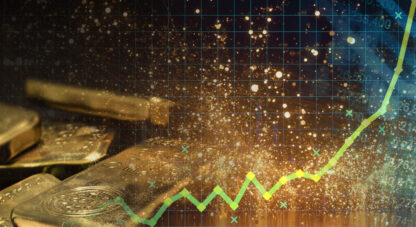Q2 2024: Just the Start
For the precious metals sector, Q2 2024 was one for the record books. According to the World Gold Council, gold demand was at record levels. Second quarter total gold demand including OTC investment increased 4% Y/Y to 1,258 tons. That marks a record for second quarter gold demand in World Gold Council data back to the year 2000. In addition, central bank net gold buying remained robust with a 6% increase over the year ago quarter. In fact, with Q1 and Q2 combined, central bank net gold purchases are on pace for another record year.
On the strength of global central bank demand and OTC investment demand in the second quarter, the LBMA gold price increased by 18% Y/Y and 13% Q/Q to a new record high quarterly average price of $2,338/oz in Q2. The strength of the gold price throughout the quarter also drove record free cash flows for numerous precious metals producers and royalty/streaming companies.
HAI sees three specific drivers to watch right now in the gold market. Central bank demand—mostly from emerging markets and the People’s Bank of China, Chinese citizen domestic buying, and finally the participation of the Western investor. These first two drivers, central bank buying and domestic Chinese buying, have already arrived in a big way. They have flat-out seized control of the gold market and are driving the ongoing price surge to record highs. The third driver—Western investors—has yet to show up and join the rally in force. However, that may now be starting to change.
Focusing on the central bank buying for a moment, the record pace of buying so far in 2024 has come in spite of the fact that the People’s Bank of China reported no additional official gold purchases in either May or June after 18 straight months of official buying. The news of a reported halt to PBOC gold purchases in early June briefly knocked the gold price lower, but gold quickly recovered when evidence surfaced that the PBOC was likely still buying gold aggressively, but now unofficially and quietly. In fact, according to Jan Nieuwenhuijs, arguably the world’s top expert on global gold flows, the data suggests that rather than halting purchases, the PBOC actually accelerated their purchases in May to upwards of 50 tons.
Central banks, the People’s Bank of China included, have been buying gold at record levels as part of a strategic move away from weaponized dollar hegemony and toward the quality and independence afforded by gold.
Reuters wrote in early July that, according to an unnamed Chinese policy insider, China’s gold reserves “need to rise in absolute and relative terms,” and that China is “expected to keep its longer-term programme to diversify exposure from U.S. dollar-denominated assets active.” The unnamed insider also confirmed to Reuters that, geopolitical factors spurred by the Russia-Ukraine war and the US weaponization of the dollar to seize Russian funds were among prominent drivers of China’s gold demand. What’s crucial to understand is that China still has the lowest share of gold reserves of any major economy. Even if the reported 4.9% share of gold reserves is understated by half, the global average is 16%, and the US and other major Western nations are closer to 67%. In other words, in order to meaningfully dedollarize, China needs to continue to buy record amounts of gold for many years.
Now, while 67% of reserves held in gold sounds good for the US, remember that the US has issued a mind-numbing amount of debt to the rest of the world. Consider that the long-term average of the market value of US official gold as a percent of foreign-held US Treasurys is 40%, while today, even at $2,500 gold, that same ratio is just 8%. In other words, gold would have to rise 5x just to get back to the long-term average of the value of US gold relative to US foreign held debt, despite the US holding a significant amount of its reserves in gold.
But back to China, it’s not just China’s central bank that’s buying gold voraciously. Chinese domestic investors are desperately pouring into gold to diversify away from their crisis-ridden property sector and sagging stock market, and protect against further yuan debasement. In addition, some Chinese speculators may be front-running PBOC purchases and contributing to higher prices. That’s likely a prime factor for the PBOC’s switch from official to unofficial gold purchases.
In fact, gold demand domestically in China during the second quarter was so strong that many investors and speculators were reportedly unable to purchase sufficient physical gold for immediate delivery. The scarcity of physical for immediate delivery ultimately spilled over into a surge in trading volume by more than two hundred percent on the Shanghai Futures Exchange over the second quarter, as record numbers of Chinese citizens were willing to take delayed delivery of their gold so long as they could lock in their purchase at the current price. The result, according to Bloomberg, was that the Shanghai Futures Exchange “reached a record bullish position in data back to 2015.”
Consider as well that buying from the PBOC and other central banks is largely price insensitive. Also consider the fact that domestic Chinese buying, which has traditionally been very price sensitive, has recently become the opposite. The physical scarcity, huge jump in volume, and extreme premiums on Chinese gold exchanges all indicate that savers, investors, and speculators are now much more willing to follow the price higher.
Given the still largely disinterested Western investor, as demonstrated by outflows from US and European gold exchange traded funds, the message is clear: emerging market central banks, BRICS nations, and Eastern investors have taken control of the gold price as an energetic block of strong and consistent buyers. In fact, between the Shanghai Gold Exchange and the Shanghai Futures Exchange, the combined average daily volume over the past two months now exceeds the average trading volume of the New York COMEX.
But now we have early indications that the Western investor is starting to inch back into the gold market. Important confirmation of increased Western investor interest and participation has come from the recently improved performance of gold mining stocks (a market sector dominated by Western participation) relative to physical gold. In addition, the World Gold Council reported that in Q2 Western ETF trends were improving. While still sluggish, ETF outflows shrank in Q2 to a minor seven-ton decline compared to a much larger 21-ton drop in Q2 2023. Furthermore, the World Gold Council importantly noted that sizable early outflows in Q2 were followed by partially offsetting minor inflows later in the quarter. Now, with the Fed almost certainly on the verge of rate cuts and a policy easing cycle beginning in September, we can certainly expect those Western ETF trends to continue to improve. After all, a rate-hiking cycle sent Western investors packing; a rate-cutting cycle should bring them right back onto the yellow brick road.
Of crucial importance, however, is that ultimately there is much more than just a rate-cutting cycle to bring the Western investor back to the gold market. Economist Henry Hazlitt observed that, “the value of any monetary unit, such as the dollar, depends not merely on the quantity of dollars but on their quality.” At present we have full fiscal dysfunction in Washington. We’ve piled up $35 trillion in debt and nearly $2 trillion in annual deficits. In raising interest rates to fight an inflation problem that our own fiscal largesse created, we’ve grown the interest expense on our debt bigger than defense spending while continuing to grow interest at a faster pace than any other major government line item. That situation is all the more alarming in the context of what noted author Niall Ferguson calls “Ferguson’s Law”— history’s unambiguous axiom that any great power that spends more on debt service (interest payments on the national debt) than on defense will not stay great for very long.
In other words, we’re rapidly killing the quality of the dollar and US Treasurys. Worse yet, the debt, deficit, and interest expense problem has now escalated to the point of compromising Fed monetary policy.
Simply put, the math of the acute fiscal mess dictates that, for the Fed, the likely path forward is to generally keep interest rates below the rate of inflation. In other words, the currency must depreciate at a higher rate than debt service payments compound, or we’re left with a vicious debt spiral fast tracking toward insolvency.
So regardless of where the inflation rate goes (and HAI certainly doesn’t believe we’ve seen the last of elevated inflation), the risk of debt spiral dynamics will likely demand an extended period of negative real rates going forward to inflate away a substantial portion of the debt burden. This is massively underappreciated by a Western investor largely distracted by AI, the “Mag Seven,” and Nvidia. Once Western investor recognition of these dynamics becomes more widespread, however, it will be tremendously bullish for monetary metals and their producers, as well as the royalty and streaming companies.
Lastly, for those unconvinced that the global landscape is indeed shifting materially, recall the observations of former Global Head of Commodity Research at Goldman Sachs Jeff Currie. As Currie recently told Bloomberg, major commodity producers are no longer automatically recycling their dollar-denominated commodity and oil revenues back into US Treasurys as a reserve asset. Gold is the new reserve asset of choice.
As Currie put it, “For the first time ever, that dollar recycling is not occurring. And what is replacing it? I like to call it gold recycling… It explains a lot, why gold prices are as strong as they are… You’re unlikely to see that dollar recycling playing out probably ever again.”
In short, whether it’s monetary and fiscal malpractice or the weaponization of the dollar, once East meets West in agreement on the need to buy gold, HAI expects the current bull market to get bigger—a whole lot bigger. In HAI’s view, Q2 2024 is just the start.
Weekly performance: The S&P 500 was nearly flat, up 0.24%. Gold was down 0.73%, silver was off 2.27%, platinum was down 3.51%, and palladium was up 2.15%. The HUI gold miners index was off 1.95%. The IFRA iShares US Infrastructure ETF was up 0.62%. Energy commodities were volatile and down on the week. WTI crude oil was off 1.71%, while natural gas was off 2.43%. The CRB Commodity Index was down 0.61%. Copper was up 0.25%. The Dow Jones US Specialty Real Estate Investment Trust Index was up 0.22%. The Vanguard Utilities ETF was up 1.09%. The dollar index was up 1.02% to close the week at 101.62. The yield on the 10-yr U.S. Treasury was up 10 bps to close at 3.90%.
Have a wonderful weekend!
Best Regards,
Morgan Lewis
Investment Strategist & Co-Portfolio Manager
MWM LLC















